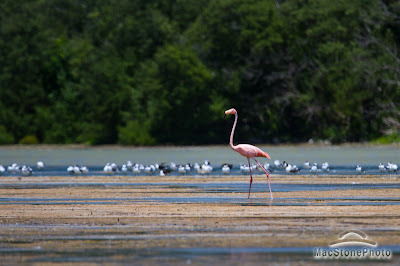The same places I've been visiting since I arrived here are still continuing to surprise me. There's no shortage of adventure and discovery in Everglades National Park, that's for sure. With my friend, coworker, and backcountry fishing guide Pete Frezza, we headed out before dawn to meet the sun as it rose over the Everglades. Launching his boat we battled swarms of mosquitoes fully understanding our blood was a necessary sacrifice for our plans that day.
Right off the bat, the calm water began rippling out from the banks as juvenile tarpon rolled violently on unsuspecting minnows. I had never seen anything like that in South Florida. The only time I watched fish rise this frequently was on the North Platte River in Wyoming, and those were 15'' trout. These were 30'' tarpon. By my third cast I had one on the fly and it sent itself rocketing into the blue morning sky. What a way to start the day!
Pete was nice enough to let me have the first casts, but promptly after I wanted to see how it was done by a pro. Watching a seasoned fisherman cast into the tight spots around mangroves is like watching an artist at work. His fly danced and line undulated in beautiful loops and fell silently on the water, presenting an unresistable morsel to the fish below.

And just when we thought it couldn't get any better than fishing on a Monday, a double rainbow appeared over the water. We stayed in this spot for the next two hours and found a few young snook which was encouraging to see since their numbers declined so abruptly after the 2010 freeze.

Despite the adrenaline-filled morning and intense satisfaction I felt, our day was far from over. A few days earlier we received word from Garl's Coastal Kayaking that they spotted a flamingo around one of the flats on Florida Bay. Historically, this wasn't an uncommon sight, as the main marina is called Flamingo from the vast numbers of pink birds that spent their summers here. Unfortunately, as a result of the plume trade, hurricanes, and continued hunting in Cuba, it's extremely rare to see these iconic birds in South Florida. While our expectations were low, our hopes soared, carrying us on a 10 mile boat ride without the use of a motor through pole and troll-only zones.


The bay was like glass and we could see redfish tailing in the flats as the tide drew out. Along the banks, dense mats of turtle grass floated on the surface, uprooted by storm surges and water currents, then elegantly arranged in lava-like tendrils of varying colors. Great white herons dotted the horizon waiting for unsuspecting toadfish and crabs to swim by. Just when it couldn't get any better, all of a sudden by the shoreline we spotted it; my very first wild flamingo.
I've seen plenty of flamingos in zoos and postcards in all the stores down here, I've even drunk out of a plastic one, but never fully appreciated these birds until this moment. I couldn't believe how they dwarfed all the shorebirds and wading birds along the coast. Maybe because they're rare, maybe because we pulled 5 miles to get there, whatever the case I was overcome with this entitled feeling that I had been let into some special club. My camera was working, batteries at full charge, and an empty memory card, things were looking good. We approached slowly, but we couldn't quite get close enough for a candid image. Wary of people, the flamingo would promptly take off as soon as we got within 50 feet, extending its long awkward neck and using the flats as its runway. It seemed to take forever for the bird to get into the air.

After another hour, we saw the flamingo land near some other wading birds. Hoping that power in numbers would make this bird feel safer we headed towards them and were able to get a little closer. Just then, my polarizer fell off my lens and scared the bird away. I managed to get some frames off just before, but still, with such a rare sighting, the images I was making didn't match what I was feeling. Fortunately, the flamingo landed with a group of white herons. Seeing the image line up, Pete helped paddle us into a position to juxtapose the mangrove islands of Florida bay and this odd family of birds against the afternoon horizon.

Given the light and the physical circumstances, I couldn't have been happier. And just in time too, because looking behind us, a storm was brewing, forcing us off the flats to bring our 15 mile pole and paddle to an end. I'm still buzzing from the energy.


























